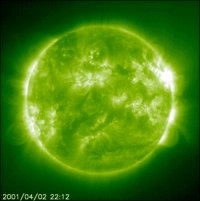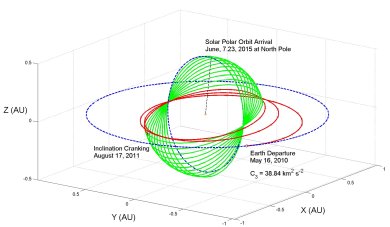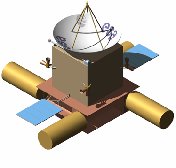The Solar Polar Orbiter
 |
|
Solar flare (SOHO/EIT ESA/NASA) |
Scientific objectives
The Solar Polar Orbiter has the following scientific objectives:
- image the global extent and dynamic effects of coronal mass ejections
- discover the sources, longitudinal structure, rotational curvature and time variability of coronal features
- link particle and field observations to images of the Sun, corona, and heliosphere at all latitudes
- determine magnetic structures and convection patterns in polar regions
- follow the evolution of solar structures over a full solar rotation
Mission Architecture
The Solar Polar Orbiter consists of a single spacecraft, launched on a Soyuz Fregat 2B from Kourou, French Guiana. The spacecraft will utilize a solar sail to lower its orbit to less than 0.5 AU before raising its inclination. After about 4 years the SPO spacecraft will achieve an inclination of approximately 83 degrees in the ecliptic coordinate frame. At this point the sail will be detached in order to perform undisturbed scientific measurements.
 |
|
The Solar Polar Orbiter trajectory |
Solar Sail
The preliminary concept for SPO employs a square solar sail with a total area of approximately 25 000 m². The characteristics of the sail are given in the table below.
| Solar Sail Characteristics | |
| Acceleration (mms-2) | 0.42 |
| Sail side 1 side (m) | ~150 |
| Sail Assembly loading (g/m²) | 8 |
| Sail material | CP-1 |
| Sail thickness | 2 micron |
Mass Budget
The preliminary mass budget is given in the table below, outlining the spacecraft and payload masses.
| Mass Budget | |
| Payload Mass | 44 kg |
| Spacecraft Dry Mass | 250 kg |
| Launch Mass | 540 kg |
The Challenges
 |
|
Boom Deployment for Sail |
Solar Sail Material: A lightweight material needs to be developed with the required optical properties to reduce system mass and requirements. The optical properties of the sail must also be preserved during the sail phase.
Solar Sail Deployment: The development of a lightweight deployment structure for a very large (~30 000 m²) sail is required.
Lightweight booms: Developments of lightweight booms with a length approaching 100 m are required. Such booms should have a specific mass of less than 100 g/m.
Solar Sail Attitude Control: There are several options for performing attitude control. The options currently under consideration include a gimbaled boom between the sail and spacecraft, moving masses along the boom structure, and tip vanes or thrusters on the booms.
Solar Sail Jettison Mechanism: The sail must be jettisoned upon reaching the final orbit in order to prevent interference with the instruments. This separation must take place with a minimum risk of collision.
Study details
This study was completed in 2004. It was carried out by SRE-PAM with the assistance of the University of Glasgow.
Contact Information
For further information about this study please contact the study manager:
Dr. Peter Falkner
Head of Planetary and Solar System Exploration Studies Section (SRE-PAP)
Advanced Studies and Technology Preparation Division (SRE-PA)
European Space Agency, ESA-ESTEC
Postbus 299, NL-2200 AG Noordwijk, The Netherlands
tel: +31 71 565 5363
e-mail: Peter.Falkner esa.int
esa.int
